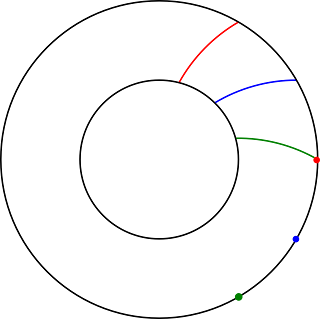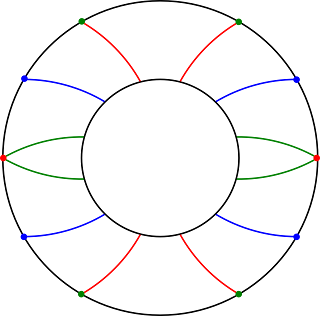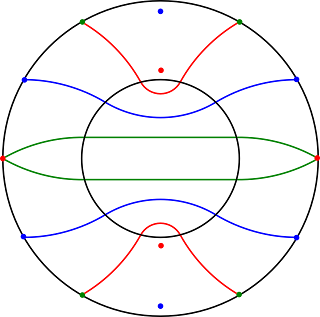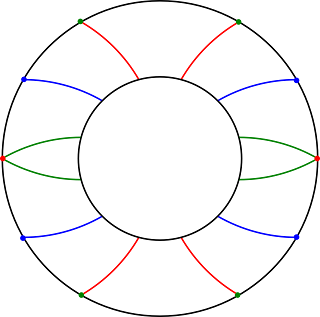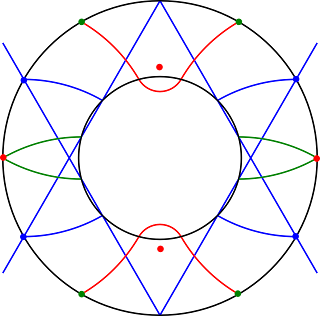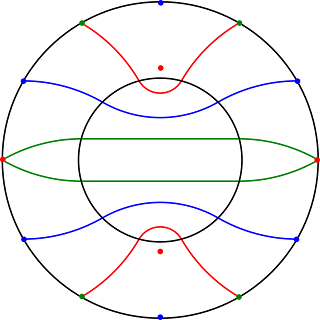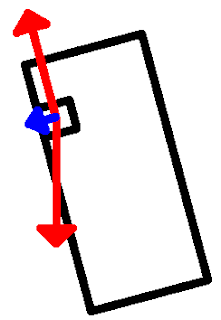This wasn't the first time I constructed this image, but when I reuse a construction, I still reconstruct it, rather than simply copying the original. But when I did that this time I discovered that I made the original one incorrectly. It wasn't exactly a mistake. I made it the way I had intended to, but I found out when I made a small change, it made the whole thing more elegant.
To explain how, I'll need to explain how I constructed it in the first place. I started with these two circles. The radius of the outer circle is R. The radius of the inner circle is R/2. They are both centered at (0, 0).
Then I added those same circles again, reflected around the x and y axes.
Then I wanted to connect the different arcs, and I want it to look smooth, so I want to make circular arcs that are tangent to the arcs they're connecting. How do I do that?
Well, if two circles are tangent, then a line drawn through the centers of both will pass through the point of tangency. So if you have a circle, and you know what point you want to be tangent, then you can draw a line through the center of that circle and through that point. Then any circle that is centered on that line and that goes through that point will be tangent to the first circle. And if you have two circles like that, and you want to find one circle that is tangent to both, then you can draw two lines. Where they intersect will be the center of the third circle.
So I'll start with the red circles. I drew lines through the centers of the red circles and the points where the red circles intersect the inner circle. Where they intersect is the center of the circular arc that connect the two arcs. Note that each red line comes close to where the other red circle intersects the outer circle, but not quite. Also, each red line comes close to where the blue circles intersect the inner circle, but again, not quite.
The I did the same thing with the blue circles. I drew a line through the center of each blue circle and the point where that circle intersects the inner circle. Note the intersection of the blue lines is close to the outer circle, but not quite on it. Also, each blue line comes close to where the green circles intersect the inner circle, but again, not quite.
The next and final step is where I noticed the mistake. Because the next step I simply drew straight line segments to connect the green arcs. The straight lines are nearly tangent to the green arcs. But not quite.
Now at this point, I could have simply found the circular arcs that would be tangent to the green arcs the same way I did for the blue and red. That would be one way of fixing it. But I wanted those green arcs to be connected by straight lines and for those line to actually be tangent to the arcs. And the only way to do that is the change the radius of the inner circle, which changes where the red and blue circles intersect it, which changes where the connecting arcs need to be. In other words, changing nearly the whole image.
So this time, I started not with the outer circle and inner circle, but rather the outer circle and one of the green circles.
Now I need to find the point on the green circle where a horizontal line will be tangent to it. A line drawn through the center of a circle will always be perpendicular to the circle and hence perpendicular to the tangent line where it intersect the circle. So what I need to do is draw a vertical line through the center of the green circle, and where it intersects the green circle is where a horizontal line will be tangent to it.
Then I can draw the inner circle with the same center as the outer circle and that goes through that point. A little bit of trigonometry shows that the radius of the new inner circle is
 R, which is approximately .5176R.
R, which is approximately .5176R.
Then I drew the other circles the same as before, between the outer circle and the new inner circle.
Again, I drew lines between the centers of the red circles and the points where they intersect the inner circle. But notice, this time they don't pass close to where the other red circle intersect the outer circle, they pass right through it. Also, although the difference is too small to notice at this scale, the red lines also pass directly through where the point where the blue circles intersect the inner circle.
And again, I drew the lines between the centers of the blue circles and the points where they intersect the inner circle. And again, notice that they don't intersect near the outer circle, they intersect directly on top of it. Also, they pass directly through the points where the green circles intersect the inner circle.
And finally, I drew the lines connecting the green arcs, and this time, they're actually tangent.
It's interesting how that one little almost imperceptible change made the whole thing more elegant.





